Parks Maintenance & Recreation Management in the Peace River Country of Alberta
All Terrain Vehicle (ORV) Safety

(Image Credits: pb-law.com)
These opinions are offered to you freely out of my training and riding experience.
FYI: I was a Park Ranger and Park Operations Supervisor for 25 years both in British Columbia and Alberta provincial parks. I was tasked with the responsibility of building a back country ATV obstacle course and teaching Parks staff, Conservation Officers and even some RCMP how to traverse extreme back country and come back safely.
This is Not a Safety Course
Each brand and each situation is a little different, read your owners manual.
This is basic and essential information
to operate any ATV and come home alive!
My purpose here is to recommend the equipment that will help keep you safe
and some riding techniques that will help you avoid hidden dangers and live to ride again.
Why are we so concerned with ATV Safety?
Quad accidents in Canada:
All-Terrain Vehicles (ATVs) are the leading cause of serious injury in children and youth.
Children aged 10 to 14 represented the most number of cases
Credits: National Library of Medicine
Canada Safety Council reports that there were over 5500 emergency department visits for ATV injuries in 2010 and the numbers are climbing.
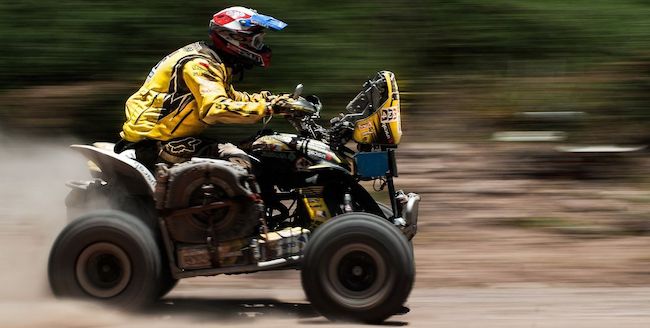
(Image credits: Superatv.com)
In my experience I have learned that:
The number 1 cause of ATV accidents is “Travelling too fast for the terrain.”
The number 2 cause of ATV accidents is not knowing how to properly counterbalance the machine to prevent a rollover on a slope or a steep incline.
What about ATV injuries and Children
What about ATV injuries and Children
ATVs, because of their design, including size and speed, require considerable strength, balance, coordination and cognitive ability to safely drive. Children do not possess the physical development to safely drive an ATV or the cognitive ability to react to potentially dangerous situations. It is not a question of an individual child’s maturity or size. The risks are related to the stage of development of the child’s body and mind.
Canada Safety Council reports that there were over 5500 emergency department visits for ATV injuries in 2010. Today the statistics are growing.

What this means is that if you are serious about going to purchase an ATV for your child, you must also be serious about that child's safety and be prepared to spend an extra amount of time training.
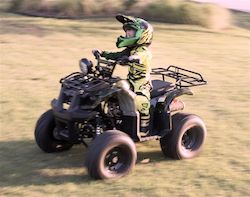
Injuries are the leading cause of hospitalization and death for children 1 to 19 years of age in Canada. ATV-related injuries are unfortunately responsible for a substantial number of these hospitalizations and deaths.
(Material and image Credits below)

I'm sorry to include this article folks but I would be remiss if I didn't give you all the facts.
Steel vs. Flesh
In an accident the object that survives the best is the strongest and weighs the most.
Will that be you or your 600 pound quad?
This means that you must learn how to control your quad to prevent a serious accident
How do you do this? You need to keep your head up and watch for obstructions and pitfalls. You drive in a safe manner and you manage the speed so it doesn’t get out of control. You also have control of the brakes to stop or slow down and you can keep the quad stable on uneven ground by counter balancing (active riding). The quad will do exactly what you tell it to do - it can't think for itself! You are the one in control.

What is momentum. As an object (like your quad) moves, it stores up energy travelling the same direction as the object. This stored up energy makes it continue on its original path, straight ahead, similar to when you throw a ball. Your arm gives the ball the energy to keep flying in a straight line after the ball leaves your hand. A quad will do the same thing making it more difficult to turn the wheels and change direction. The faster you travel, the more difficult it will be to change direction without tipping, but you can easily control the strength of your quad's momentum by reducing the speed. The lower the speed the less the force of momentum is against you and the safer it is to change direction. What does this mean? It means SLOW DOWN FOR A TURN!
The second invisible force that can surprise you is called “Gravity.” Gravity pulls down on your machine which is a good thing or you would float off into space. BUT, if the ATV is on a steep incline, gravity pull can actually cause the machine to roll over. This could be frontward, backward or sideways. Further down we will be talking about how to control your quad so that this does not happen.
Driving on pavement:
Every quad manual and every quad course advises the operator not to drive on pavement. Of course you can cross a paved road and yes, you can, if you're careful, travel on pavement if you understand the dangers.
The reason that quad manufacturers warn against driving on pavement is for two reasons. The first reason is that your quad has very low tire pressure, which makes it grab the pavement more than a high pressure tire would. Secondly, your quad has what is called a live axel. This means that the rear axel does not have a differential and both wheels travel at the same speed. Because of this, one wheel has to spin or slip when you are in a turn, which isn't a problem on soft ground but on pavement it can cause the machine to flip over at high speeds.
So, let's learn how to be in control and be safe,
after all you are out here to have fun and accidents are NO fun.
Keeping your body safe
Before we even think about how to learn to ride an ATV we have to think about how we are going to keep our body safe from cold, rain, brush, branches, dirt and rough riding.
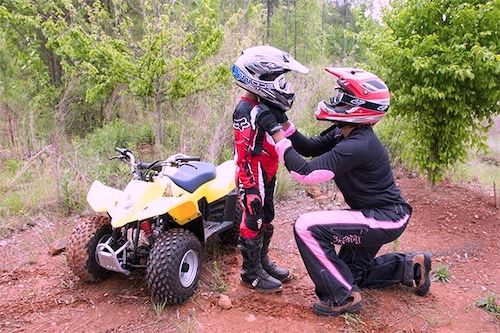
Way to go mom!
(Image compliments of ATV Safety Institute)
So we need protective gear. A helmet - protective clothing - good footwear - protection for your hands and safety glasses or goggles.
You might say, "But I can't afford to buy all that gear." Well, let's see. A helmet is basic and it is the law, so you need a helmet for sure. Sometimes, I find good helmets at the Salvation Army. Then, I'm sure you can find long pants and a long shirt or jacket in your closet, that would help. Gloves are cheap and you need them anyway when winter comes. Then, good footwear means something sturdy, not flip flops or runners, okay?
Goggles may be expensive but a pair of safety glasses from your hardware store are around $3.00. That's all I'm talking about, nothing fancy, just practical.
Choosing which ATV is right for you
Then we need to consider what size of ATV is right for you. This should be determined by your weight and size rather than your age. Saying that you should be at least 16 years old doesn’t help you if you’re only an 80 pound person. You could be 14 years old and be 150 pounds and physically strong enough to handle an adult quad. The ATV industry has attempted to set guidelines to help people determine which machine is more suited to you and every machine has a warning label to make you aware what size of a person it was designed for.
The reason this is important is that the quad driver must be able to counterbalance their machine when traversing uneven terrain. This means that a light person on an adult ATV won’t likely be able to prevent a rollover when travelling on a slope or up a steep incline.
Before we ride let’s look at your ATV's reliability
Is it going to get you home again?
When it is time to ride, you will already be dressed for body protection and have the right sized ATV for your weight.
Now let’s check the machine, this is called a pre-ride inspection.
What to check: Are the tires pumped up properly? Give them a kick to see how hard they are. Make sure the brakes work! Check to see if the controls all work - the shifter - the throttle - foot brakes and lights etc. Do you have enough fuel to get back home? (Every so often you should check to see if all the tires have even pressure. This requires a low pressure tire gauge and the pressure should usually be between 4 and 6 pounds)
Time to Ride
First, get on the machine and shift the transmission into neutral to start the engine. Is the parking brake on? In cooler climates always let the engine warm up before roaring off. If you don't do this your engine won't last very long. Keep your head up and look ahead, it is so easy to run into an overhanging branch or drive into a hole. Keep your feet on the foot pegs to avoid injury and maintain stability. Keeping your feet on the pegs means you won’t break your legs.
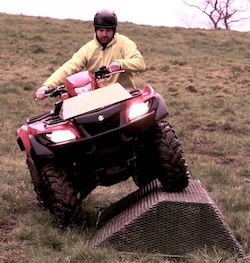
This means move around on the seat to balance the machine. That is why the seat is made long and wide, it is not for carrying another rider. This is called counter balancing your machine to prevent roll over. (Image credits: Safe Family Farms MED partnership group)
Cornering
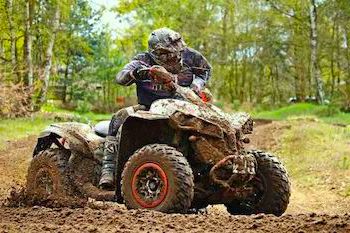
Lean into a turn and put your weight on the outside foot peg. This will help keep the machine’s centre of gravity (cg) low and centred. When on a slope, lean toward the upside of the slope to keep from rolling over. (Image credits: Boy Scouts of America)

Climbing an incline
When climbing a hill or driving on uneven terrain always stand up. This lowers your centre of gravity (cg) and makes your machine much more stable.
Find the best, most gentle part of the hill to climb. When approaching the hill, stand up and lean forward with your feet on the foot pegs. The further you are able to lean forward the steeper the hill you can climb without flipping over.
If you get stopped on the hill or the machine powers out, grab the front brake first, (left brake lever) then the rear brake (right brake lever) to prevent rolling over backward. Then you can back down slowly or try and get off on the high side of the machine in case it begins to slide. On real steep inclines or on steep side hills I always suggest being ready to bail off just in case the quad drops into a hole on the downhill side and it starts to roll over. Better to bail off and save your body than to try and hang on through a roll over.
Towing
Never attach a tow line to the carrier racks. Attach to a low point like the hitch or the back axel. Tying high can flip your machine over on top of you.
Carrying Cargo
Carrying cargo or passengers will raise the cg (Center of Gravity of the machine) high enough to easily tip over or flip upside down. The quad is designed to carry the weight of one person. When carrying cargo or another person the cg is then much higher and the riding dynamics are changed dramatically. In real life we all need to carry loads or at times even another person on our ATVs. What you need to know is that maneuverability is limited when carrying a load. You must slow down and be extra cautious on uneven ground. Climbing a steep incline is particularly dangerous with a load. Stop, reposition some of the load to the front carrier to balance your machine. I have seen a quad flip right over backwards going up hill carrying a person on the back carrier.
Loading and Unloading
Minimize the ramp angle. This might mean backing your truck or trailer into a low spot or ditch. Always fasten the ramp in place so it can’t slide off the truck or trailer when loading.
Just like going up an incline, post (Lean) forward when loading and unloading to keep from flipping over backwards. Use steady power and go slowly when loading. Don’t stop on the ramp, keep moving. Sudden acceleration can spin the ramps out from under your machine. Many accidents happen because riders do not watch if the wheels are lined up with the ramp as they are loading.

In this photo you can see proper loading technique.
Man is standing, leaning forward and note the ramps are strapped to the truck
(image compliments of discount ramps .com)
Advanced understanding of Center of Gravity
Many rural Canadians grow up around equipment and All Terrain Vehicles, and most are confident ATV operators. So WHY do we still have all these accidents?
I believe that although adults and young people may be familiar with operating an ATV, they may not be aware of the invisible, physical dynamics that actually cause an accident.
I taught extreme back country ATV operation and safety for Alberta Provincial Parks / Fish and Wildlife. Virtually all of my students were experienced ATV drivers but very few understood the dynamics of how manipulating the centre of gravity (cg) was key to quad safety.
So then, in my opinion, the basis of every quad safety course must include a thorough explanation of how a rider can manipulate cg to prevent rollovers and unstable, potentially dangerous situations when riding on uneven ground.
Most ATVs are used in off-road situations where traversing over hills and along slopes is common and requires the rider to be active on the quad to counterbalance the machine in motion. I maintain that while the rider’s body movement can counterbalance the ATV it also changes the centre of gravity of the machine, making the maneuver even safer.
So let’s see what cg force actually does. Ever notice how a race car is built? As low to the ground as possible, right?That is because at 200 mph that car would flip right over on a curve if the cg were any higher. A race car is deliberately built low to keep the mass weight or the cg as low as possible.

(Image compliments of the University of Alberta)
Good examples of altering a vehicle's cg are shown in the pictures below. The hunter won't be able to travel on much of a slope before this quad rolls over because of the weight on his carrier and the truck with the ATVs up high on the deck is very tippy on side hills or travelling around curves at higher.
So, whether you're carrying a hay bale or a box of tools on the carrier it will cause your safe centre of gravity to be altered and make your machine less stable on uneven terrain. The same thing occurs when you carry a passenger on the seat behind you.
As I mentioned before, if you must carry a passenger, be very aware that the quad will be much easier to roll over on uneven ground, so go slower, and both riders must shift their weight to help counter balance the quad on an incline or slope.


So, why do I recommend being an "active" rider
moving around on the machine to balance the motion?
When an ATV or Snowmobile operator leans into a turn he is using his body weight to shift the cg of the machine more to the inside of the turn to offset the pull of momentum drawing the machine to the outside of the turn. If he didn’t do this, the momentum would pull the ATV the opposite way the driver wants to go. By standing on the foot pegs at the same time, the operator moves his full weight to the lowest point on the machine. This lowers the cg and makes the machine much more difficult to roll over.
What about traversing a slope or a steep incline?
When the ATV driver rests his weight on the seat it actually raises the cg of the machine, making it more unstable on a slope or an incline. This is so important that I mention this again. By standing up on the foot pegs, the driver places his full weight on the lowest part of the ATV, effectively lowering the cg and making the machine much harder to tip over. I recommend standing up on a quad or snow machine any time you’re negotiating uneven ground. A lower centre of gravity always stabilizes the machine. The other advantage of standing on your machine is that you can use your upper body weight to more effectively counterbalance the movement of the machine by leaning into the slope or incline.
I’ve always made my ATV students stand up on their machines when we were on uneven ground for this purpose. Next time you’re riding over very uneven ground, try standing and you’ll discover that you have way more control of the machine. Another advantage of standing is that you are carrying your weight with your legs, which will soften the shock to your body when travelling over rough ground.
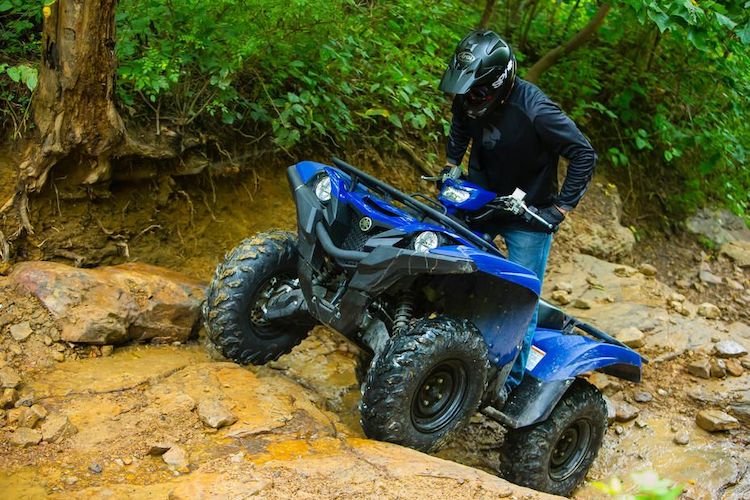
Here is a great example of a rider balancing his machine by posting forward and standing on the foot pegs to lower the center of gravity.
Exam time - What's wrong with these pictures (click)
Exam time - What's wrong with these pictures (click)
In each of the mages below can you pick out what could be wrong and how it could lead to an accident

How many people can you fit on a quad?
The CG is just way too high here
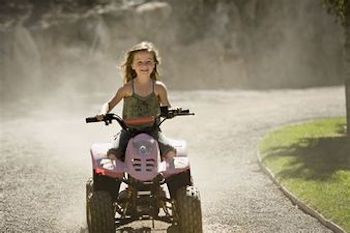
What would happen to this little lady if her quad took a spill?
Need protective clothing and a helmet
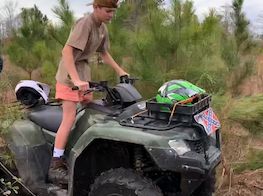
Would you think the helmet might be better on this boy's head than on the carrier?
How about some protective clothing?
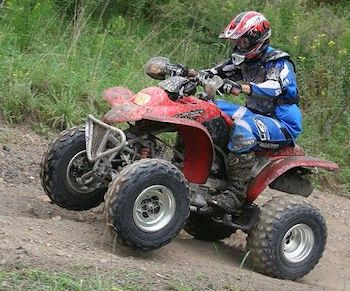
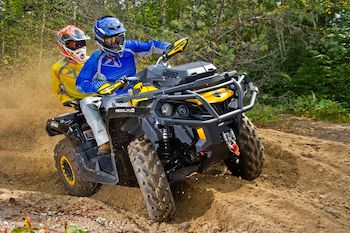
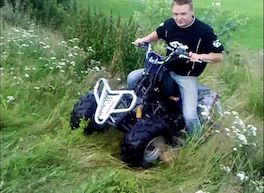
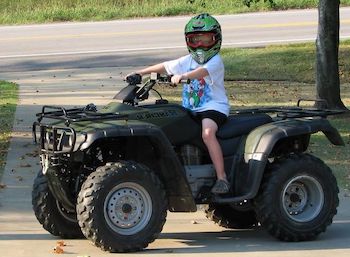
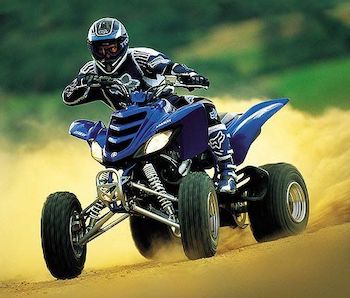
UTV / ORV Safety

UTV / ORV Safety


(Image Credits: Top - HiConsumption.com / Bottom - Polaris Ranger / UTV planet Magazine)
Side by Side / UTV / ORV Safety
My findings: A side by side is a handy, fun, very useful tool to have, but like any machine there are things to consider to keep yourself safe. As with a regular ATV, one must consider the age and size of the operator and ensure adequate training for new drivers.
Operating off road on uneven ground presents all the same dynamics that you encounter in a regular 4-wheeler, so all the same precautions must be taken. The main difference is that with a larger off road vehicle like this Side by Side you can't counter balance the machine to prevent a roll over. You can limit the size and weight of the load you carry, however, which will enhance how the machine performs on uneven ground.
People ask: Are UTVs or Side by Sides any safer than regular 4-wheelers or quads?
According to some agencies: A side by side or UTV presents an inherent roll over risk. This is obviously because they are much larger and heavier and the operator cannot effectively counterbalance the machine. More care has to be taken on uneven ground. These machines have a higher centre of gravity that you cannot control like you can a quad.
Having said that, it would also be true that keeping your pay load to a minimum would surely help prevent a roll over.
Some agencies report that UTVs cause twice as many injuries as regular quads.
UTVs are top heavy and can haul as many as 6 people, so speed then would be a safety factor to consider.
UTVs give an operator a false sense of security when in fact they are top heavy and easy to roll.
UTVs are not suited to younger, inexperienced drivers. These machines have more power, more weight and are capable of high speeds. The key here of course, is training and supervision.
UTV drivers are still recommended to wear all the safety gear.
Instead of being an active rider like you need to be on a quad, it is safer to do up your seat belt and trust the roll over cage to protect you from harm.
Valuable ATV Safety Links
Valuable ATV Safety Links